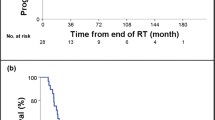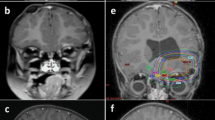Abstract
Purpose
Atypical teratoid/rhabdoid tumors (ATRT) of the central nervous system (CNS) are rare tumors with a poor prognosis and variable use of either focal or craniospinal (CSI) radiotherapy (RT). Outcomes on the prospective Pediatric Proton/Photon Consortium Registry (PPCR) were evaluated according to RT delivered.
Methods
Pediatric patients receiving RT were prospectively enrolled on PPCR to collect initial patient, disease, and treatment factors as well as provide follow-up for patient outcomes. All ATRT patients with evaluable data were included. Kaplan–Meier analyses with log-rank p-values and cox proportional hazards regression were performed.
Results
The PPCR ATRT cohort includes 68 evaluable ATRT patients (median age 2.6 years, range 0.71–15.40) from 2012 to 2021. Median follow-up was 40.8 months (range 3.4–107.7). Treatment included surgery (65% initial gross total resection or GTR), chemotherapy (60% with myeloablative therapy including stem cell rescue) and RT. For patients with M0 stage (n = 60), 50 (83%) had focal RT and 10 (17%) had CSI. Among patients with M + stage (n = 8), 3 had focal RT and 5 had CSI. Four-year overall survival (OS, n = 68) was 56% with no differences observed between M0 and M + stage patients (p = 0.848). Local Control (LC) at 4 years did not show a difference for lower primary dose (50–53.9 Gy) compared to ≥ 54 Gy (73.3% vs 74.7%, p = 0.83). For patients with M0 disease, four-year OS for focal RT was 54.6% and for CSI was 60% (Hazard Ratio 1.04, p = 0.95. Four-year event free survival (EFS) among M0 patients for focal RT was 45.6% and for CSI was 60% (Hazard Ratio 0.71, p = 0.519). For all patients, the 4-year OS comparing focal RT with CSI was 54.4% vs 60% respectively (p = 0.944), and the 4-year EFS for focal RT or CSI was 42.8% vs 51.4% respectively (p = 0.610).
Conclusion
The PPCR ATRT cohort found no differences in outcomes according to receipt of either higher primary dose or larger RT field (CSI). However, most patients were M0 and received focal RT. A lower primary dose (50.4 Gy), regardless of patient age, is appealing for further study as part of multi-modality therapy.




Similar content being viewed by others
Change history
27 July 2023
A Correction to this paper has been published: https://doi.org/10.1007/s11060-023-04405-4
References
Ostrom QT, Price M, Ryan K, Edelson J, Neff C, Cioffi G et al (2022) CBTRUS statistical report: pediatric brain tumor foundation childhood and adolescent primary brain and other central nervous system tumors diagnosed in the United States in 2014–2018. Neuro Oncol 24(Suppl 3):1–38. https://doi.org/10.1093/neuonc/noac161
Burger PC, Yu IT, Tihan T, Friedman HS, Strother DR, Kepner JL et al (1998) Atypical teratoid/rhabdoid tumor of the central nervous system: a highly malignant tumor of infancy and childhood frequently mistaken for medulloblastoma: a Pediatric Oncology Group study. Am J Surg Pathol 22(9):1083–1092
Chi SN, Zimmerman MA, Yao X, Cohen KJ, Burger P, Biegel JA et al (2009) Intensive multimodality treatment for children with newly diagnosed CNS atypical teratoid rhabdoid tumor. J Clin Oncol 27(3):385–389. https://doi.org/10.1200/jco.2008.18.7724
SIOP Abstracts (2021) Abstracts. Pediatr Blood Cancer 68(S5):e29349. https://doi.org/10.1002/pbc.29349
Bartelheim K, Nemes K, Seeringer A, Kerl K, Buechner J, Boos J et al (2016) Improved 6-year overall survival in AT/RT: results of the registry study Rhabdoid 2007. Cancer Med 5(8):1765–1775. https://doi.org/10.1002/cam4.741
Hoffman LM, Richardson EA, Ho B, Margol A, Reddy A, Lafay-Cousin L et al (2020) Advancing biology-based therapeutic approaches for atypical teratoid rhabdoid tumors. Neuro Oncol 22(7):944–954. https://doi.org/10.1093/neuonc/noaa046
Benesch M, Bartelheim K, Fleischhack G, Gruhn B, Schlegel PG, Witt O et al (2014) High-dose chemotherapy (HDCT) with auto-SCT in children with atypical teratoid/rhabdoid tumors (AT/RT): a report from the European Rhabdoid Registry (EU-RHAB). Bone Marrow Transplant 49(3):370–375. https://doi.org/10.1038/bmt.2013.208
Gardner SL, Asgharzadeh S, Green A, Horn B, McCowage G, Finlay J (2008) Intensive induction chemotherapy followed by high dose chemotherapy with autologous hematopoietic progenitor cell rescue in young children newly diagnosed with central nervous system atypical teratoid rhabdoid tumors. Pediatr Blood Cancer 51(2):235–240. https://doi.org/10.1002/pbc.21578
Zaky W, Dhall G, Ji L, Haley K, Allen J, Atlas M et al (2014) Intensive induction chemotherapy followed by myeloablative chemotherapy with autologous hematopoietic progenitor cell rescue for young children newly-diagnosed with central nervous system atypical teratoid/rhabdoid tumors: the Head Start III experience. Pediatr Blood Cancer 61(1):95–101. https://doi.org/10.1002/pbc.24648
Slavc I, Chocholous M, Leiss U, Haberler C, Peyrl A, Azizi AA et al (2014) Atypical teratoid rhabdoid tumor: improved long-term survival with an intensive multimodal therapy and delayed radiotherapy. The Medical University of Vienna Experience 1992–2012. Cancer Med 3(1):91–100. https://doi.org/10.1002/cam4.161
Cohen BH, Geyer JR, Miller DC, Curran JG, Zhou T, Holmes E et al (2015) Pilot study of intensive chemotherapy with peripheral hematopoietic cell support for children less than 3 years of age with malignant brain tumors, the CCG-99703 phase I/II study. A report from the children’s oncology group. Pediatr Neurol 53(1):31–46. https://doi.org/10.1016/j.pediatrneurol.2015.03.019
Lafay-Cousin L, Hawkins C, Carret AS, Johnston D, Zelcer S, Wilson B et al (2012) Central nervous system atypical teratoid rhabdoid tumours: the Canadian Paediatric Brain Tumour Consortium experience. Eur J Cancer 48(3):353–359. https://doi.org/10.1016/j.ejca.2011.09.005
Buscariollo DL, Park HS, Roberts KB, Yu JB (2012) Survival outcomes in atypical teratoid rhabdoid tumor for patients undergoing radiotherapy in a surveillance, epidemiology, and end results analysis. Cancer 118(17):4212–4219. https://doi.org/10.1002/cncr.27373
Fischer-Valuck BW, Chen I, Srivastava AJ, Floberg JM, Rao YJ, King AA et al (2017) Assessment of the treatment approach and survival outcomes in a modern cohort of patients with atypical teratoid rhabdoid tumors using the National Cancer Database. Cancer 123(4):682–687. https://doi.org/10.1002/cncr.30405
Fruhwald MC, Hasselblatt M, Nemes K, Bens S, Steinbugl M, Johann PD et al (2020) Age and DNA methylation subgroup as potential independent risk factors for treatment stratification in children with atypical teratoid/rhabdoid tumors. Neuro Oncol 22(7):1006–1017. https://doi.org/10.1093/neuonc/noz244
Louis DN, Ohgaki H, Wiestler OD, Cavenee WK, Burger PC, Jouvet A et al (2007) The 2007 WHO classification of tumours of the central nervous system. Acta Neuropathol 114(2):97–109. https://doi.org/10.1007/s00401-007-0243-4
McGovern SL, Okcu MF, Munsell MF, Kumbalasseriyil N, Grosshans DR, McAleer MF et al (2014) Outcomes and acute toxicities of proton therapy for pediatric atypical teratoid/rhabdoid tumor of the central nervous system. Int J Radiat Oncol Biol Phys 90(5):1143–1152. https://doi.org/10.1016/j.ijrobp.2014.08.354
Pai Panandiker AS, Merchant TE, Beltran C, Wu S, Sharma S, Boop FA et al (2012) Sequencing of local therapy affects the pattern of treatment failure and survival in children with atypical teratoid rhabdoid tumors of the central nervous system. Int J Radiat Oncol Biol Phys 82(5):1756–1763. https://doi.org/10.1016/j.ijrobp.2011.02.059
De Amorim BK, Sethi R, Trofimov A, Zeng C, Fullerton B, Yeap BY et al (2013) Early clinical outcomes using proton radiation for children with central nervous system atypical teratoid rhabdoid tumors. Int J Radiat Oncol Biol Phys 86(1):114–120. https://doi.org/10.1016/j.ijrobp.2012.12.004
Reddy AT, Strother DR, Judkins AR, Burger PC, Pollack IF, Krailo MD et al (2020) Efficacy of high-dose chemotherapy and three-dimensional conformal radiation for atypical teratoid/rhabdoid tumor: a report from the children’s oncology group trial ACNS0333. J Clin Oncol 38(11):1175–1185. https://doi.org/10.1200/JCO.19.01776
Hess CB, Indelicato DJ, Paulino AC, Hartsell WF, Hill-Kayser CE, Perkins SM et al (2018) An update from the pediatric proton consortium registry. Front Oncol 8:165. https://doi.org/10.3389/fonc.2018.00165
Harris PA, Taylor R, Thielke R, Payne J, Gonzalez N, Conde JG (2009) Research electronic data capture (REDCap): a metadata-driven methodology and workflow process for providing translational research informatics support. J Biomed Inform 42(2):377–381. https://doi.org/10.1016/j.jbi.2008.08.010
Strother DR, Lafay-Cousin L, Boyett JM, Burger P, Aronin P, Constine L et al (2014) Benefit from prolonged dose-intensive chemotherapy for infants with malignant brain tumors is restricted to patients with ependymoma: a report of the Pediatric Oncology Group randomized controlled trial 9233/34. Neuro Oncol 16(3):457–465. https://doi.org/10.1093/neuonc/not163
Packer RJ, Biegel JA, Blaney S, Finlay J, Geyer JR, Heideman R et al (2002) Atypical teratoid/rhabdoid tumor of the central nervous system: report on workshop. J Pediatr Hematol Oncol 24(5):337–342
Reddy AT, Krailo MD, Buxton AB, Strother DR, Huang A, Zhou T et al (2020) Reply to S.A. Upadhyaya. J Clin Oncol 38(28):3353–3354. https://doi.org/10.1200/JCO.20.01573
Chen YW, Wong TT, Ho DM, Huang PI, Chang KP, Shiau CY et al (2006) Impact of radiotherapy for pediatric CNS atypical teratoid/rhabdoid tumor (single institute experience). Int J Radiat Oncol Biol Phys 64(4):1038–1043. https://doi.org/10.1016/j.ijrobp.2005.10.001
Lawell MP, Indelicato DJ, Paulino AC, Hartsell W, Laack NN, Ermoian RP et al (2020) An open invitation to join the pediatric proton/photon consortium registry to standardize data collection in pediatric radiation oncology. Br J Radiol 93(1107):20190673. https://doi.org/10.1259/bjr.20190673
Baliga S, Yock TI (2019) Proton beam therapy in pediatric oncology. Curr Opin Pediatr 31(1):28–34. https://doi.org/10.1097/MOP.0000000000000724
Indelicato DJ, Flampouri S, Rotondo RL, Bradley JA, Morris CG, Aldana PR et al (2014) Incidence and dosimetric parameters of pediatric brainstem toxicity following proton therapy. Acta Oncol 53(10):1298–1304. https://doi.org/10.3109/0284186X.2014.957414
Upadhyay R, Liao K, Grosshans DR, McGovern SL, McAleer MF, Zaky W et al (2022) Quantifying the risk and dosimetric variables of symptomatic brainstem injury after proton beam radiation in pediatric brain tumors. Neuro Oncol. https://doi.org/10.1093/neuonc/noac044
Funding
Data for this project was obtained from the multi-center Pediatric Proton and Photon Consortium Registry (PPCR) sponsored by the NIH/MGH. The PPCR is supported by the Federal Share of program income earned by Massachusetts General Hospital on C06 CA059267, Proton Therapy Research and Treatment Center.
Author information
Authors and Affiliations
Contributions
All authors contributed to the study conception and design. Material preparation, data collection, and analysis were performed by Andrew Roehrig, Paul Aridgides, Torunn Yock, Daniel Indelicato, Sarah Gallotto, and Benjamin Bajaj. The first draft of the manuscript was written by Andrew Roehrig and Paul Aridgides and all authors commented on previous versions of the manuscript. All authors read and approved the final manuscript.
Corresponding author
Ethics declarations
Competing interests
The authors declare no competing interests.
Additional information
Publisher's Note
Springer Nature remains neutral with regard to jurisdictional claims in published maps and institutional affiliations.
Paul Aridgides and Torunn I. Yock contributed equally as co-senior authors.
The original version of this article has been revised: Figure 4 has been corrected
Supplementary Information
Below is the link to the electronic supplementary material.
Rights and permissions
Springer Nature or its licensor (e.g. a society or other partner) holds exclusive rights to this article under a publishing agreement with the author(s) or other rightsholder(s); author self-archiving of the accepted manuscript version of this article is solely governed by the terms of such publishing agreement and applicable law.
About this article
Cite this article
Roehrig, A., Indelicato, D.J., Paulino, A.C. et al. Radiotherapy for Atypical Teratoid/Rhabdoid Tumor (ATRT) on the Pediatric Proton/Photon Consortium Registry (PPCR). J Neurooncol 162, 353–362 (2023). https://doi.org/10.1007/s11060-023-04296-5
Received:
Accepted:
Published:
Issue Date:
DOI: https://doi.org/10.1007/s11060-023-04296-5




